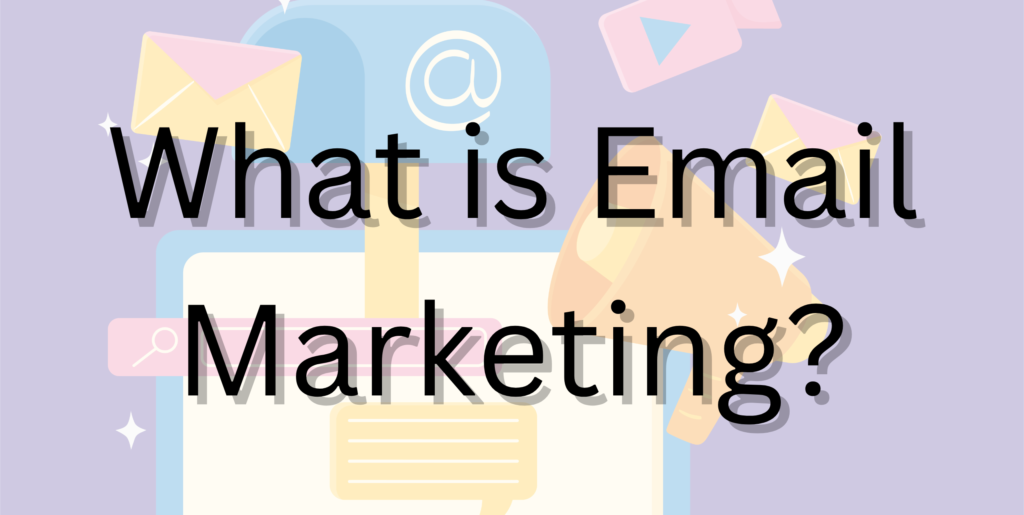Understanding Email Marketing: A Complete Guide
Email marketing is one of the most powerful digital marketing strategies available today. It helps businesses connect with their audience, nurture leads, and drive sales at a low cost. This guide will take you through the basics of email marketing, its benefits, types, best practices, and tools to help you craft successful email campaigns.

What is Email Marketing?

Email marketing is an online marketing process through which emails are delivered to the targeted group of receivers. These can have any kind of purpose, which can include:
Promotional Emails: Communicate the offer, promotion, or new product launch.
Transactional Emails: Transactional messages include sending out confirmations about purchases and shipments.
Informative Emails: Updates regarding the company and valuable content are sent out mostly in the form of newsletters.
Welcome Emails: Communication is started with the newly subscribed people or customers.
Email marketing provides a basic objective to the companies: relations with the customers and prospective customers lead to engagement in
increased sales.
THE IMPORTANCE OF EMAIL MARKETING
Email marketing is not a type of message but rather one strategic approach that can provide incredible returns on investment (ROI). According to industry studies, email marketing averages 42 dollars for every dollar it spends 2. That’s some pretty impressive numbers to state why email marketing has earned a place in many of the most used digital marketing schemes.
Advantages of Email Marketing

Cost-Effective: Email marketing is relatively cheaper than traditional forms of advertising. Most email services offer tiered pricing depending on the number of subscribers and emails sent.
High ROI: High returns are a potential in email marketing, which makes it an attractive business opportunity.
Targeted Messaging: With email, segmentation, and personalization can be achieved, meaning businesses can send targeted messages to the
relevant audience segments.
Measurable Results: Email marketing platforms offer analytics that can be used by marketers to track open rates, click-through rates, conversions, and other metrics.
Customer Relationship Building: The frequency of emailing helps to foster leads and keep in touch with the customers.
Developing an Email Marketing Strategy
To build a successful email marketing strategy requires several steps:
- Define Your Goals
Before sending out the email campaign, it’s important to define what you want to achieve. Common goals include:
Brand awareness
Growing your subscriber list
Driving sales or conversions
Engaging with customers better
Specific, measurable objectives will direct your campaign development24 - Select an appropriate email marketing software
Picking the right email marketing tool is critical for success in your campaign. Among them are:
Mailchimp – Simple to use and highly functional.
Constant Contact: Exemplary customer service with good training materials.
Send in Blue: Includes the service of SMS marketing besides the services of email.
Consider options that offer features like list segmentation, automated options, A/B testing capabilities, and analytics reporting when choosing your platform34. - Create Your Email List
An email list is the lifeblood of any campaign. There are effective strategies for building up your list:
Add opt-in forms to your website
Promote your newsletter using social media
Provide incentives, such as discounts or free resources, in exchange for sign-ups.
Host webinars or events that require registration25. - Segment Your Audience
Segmentation allows you to tailor your messages based on specific characteristics such as demographics, purchase history, or engagement levels. This ensures that recipients receive relevant content that meets their needs45.
Crafting Effective Emails
The success of your email campaigns hinges on the quality of your emails. Here are some best practices:
- Write Compelling Subject Lines
Your subject line is the first thing recipients see; it has to grab their attention and make them want to open the email. Here are some ideas:
Clear promotions (e.g., “Get 20% Off Your Next Purchase”)
Urgency (e.g., “Last Chance! Sale Ends Tonight”)
Personalization (e.g., “John, Your Exclusive Offer Awaits”) - Organize Your Content Appropriately
Since recipients usually skim through emails quickly, structure your content for easy readability:
Place the most essential information at the top
Use bullet points or numbered lists for clarity
Use distinct calls-to-action (CTAs) that guide viewers on what to do next. - Design Matters
A beautiful design creates engagement but do not put too much into the actual layout. Keep your color scheme simple (ideally with three colors) and make sure your designs reflect your brand identity13
Measurement of Success
After you have sent your e-mails, it is important to monitor how they are performing to continue improving. Metrics to track include:
1)Open Rate: The percentage of recipients who opened your e-mail.
2)Click-Through Rate (CTR): The percentage of recipients who clicked links within your e-mail.
3)Conversion Rate: The percentage of recipients who completed a desired action such as making a purchase.
Use these metrics to analyze what works and what doesn’t so you can refine future campaigns accordingly.
Legal Issues in Email Marketing
The best practice for conducting email marketing campaigns is following the legal requirements. Legal requirements include the General Data Protection Regulation (GDPR) in Europe and the CAN-SPAM Act in the United States. Important ones are:
Obtaining explicit consent from the list of subscribers before sending emails.
The process to unsubscribe from the sender’s mailing list must be easy.
The sender’s physical address should be included in every email.
Conclusion
E-mail marketing is a strong instrument able to generate huge effects while used appropriately. This consists of knowing what aspects involve composing goals, appropriate tools, interesting content, and result measurement in creating a suitable campaign for your target population.
By using emails to foster customer relationships with high ROI potential, learning email marketing should be prioritized by any business intent on improving its digital marketing. Whether you’re getting started or looking to beef up existing campaigns, putting in place these strategies will see the total potential of email marketing taken out in today’s competitive terrain.
Instagram: digi.specta
Facebook: Digispecta
